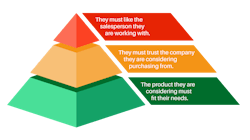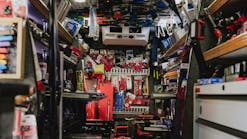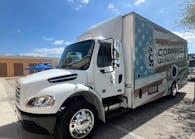Content brought to you by Professional Distributor. To subscribe, click here.
I looked up the hierarchy of our basic human needs and just as I barely remembered from school, they are food (including water), shelter, and clothing. This got me thinking about the hierarchy of the three basic needs of a prospective customer during the sales process.
The hierarchy of a customer’s need are:
1.They must like the salesperson their working with.
2. They must trust the company their considering purchasing from.
3. The product they're considering must fit their needs.
In your case, you must surely have the technicians’ trust, since you see them every week or so, and they probably already have an open account with you.
You’re driving a mobile store with one of the major brands painted on the sides or you’re an independent selling a major brand-name product. Therefore, the technician most certainly trusts the brand you are presenting to them.
So, in the end it comes down to two things: How well your demonstration conveys all the features and benefits the product has to meet their needs; and how well you close the sale.
This month we’re exploring how you too can give world class demonstrations that motivate your customers to buy from you.
First, just like a boy or girl scout, be prepared. Be 100 percent sure you totally understand the product you are about to demo. Thoroughly understand the features and benefits of the product. It is another unproven fact that if you know about the top 25 features and benefits of the product, the first person you demonstrate to will ask you about number 26. It never fails.
The normal presentation sequence is quite straight forward: Opening, feature/benefit, feature/benefit, trial close, feature/benefit, and so on
In review of previous articles, let’s be sure you know that a feature is “what it is” and the benefit is “what that benefit means to the user.” For instance: in a Mueller-Kueps Hose Clamp Compressor shown in the December issue of Professional Distributor, they state there are three different types of jaws available. That is the feature. Then in the same sentence they give the benefit to the user: Eliminating the need to purchase multiple hose clamp pliers. This is the perfect way to present a product in an advertisement or in a demonstration.All good manufactures will provide you with a list of the features of their products, but a great manufacture will also provide you with the benefits.
Your first step in assembling a great demonstration is to develop a list of all the features you can find about the product you will be presenting. Secondly develop a corresponding list of the benefits of each feature. We call this the F/B list. If you can customize the benefits directly to your prospect even better. For example, you might say, “As an Audi technician this tool will help you secure those hard-to-reach bolts behind the starter.”
Now put those F/Bs in a logical order. Back in my KNIPEX days we would start at the tip of the jaw and work our way back through the blades then to the joint and then to the end of the handle. A feature is the cross-hatch jaws, and a benefit is that it gives you great gripping power without slipping, etc.
The reason to put these in a logical order is so you can easily remember them. If the product has an on/off switch, start there. Jumping around as you present the features may cause you to miss an import feature and could also confuse the customer.
I know that after you have demonstrated a tool 50 times you start to get a bit bored with it. Think of it this way: You go to see your favorite musician and they cut out verses because they are bored singing the song. You go to a play performance, and they skip act two because they're tired. That will never happen nor should it with your demonstration. That feature/benefit you just skipped could very well be the difference between a sale or no-sale.
As you begin your demonstration never ever, never ever, never ever hand your prospect a piece of literature or the product to play with. It is another unproven fact that as soon as you hand the prospect anything to read or play with their hearing shuts off and they do not hear a word you are saying. They are also able to bring up objections that you were going to cover in your demonstration.
As you proceed through your demonstration be sure to “trial close” after every second or third feature and certainly after any significant feature. Additionally, if you get the feeling your prospect is losing interest you can use trial closing to get them back involved in the conversation.
A trial close is simply a way of taking the temperature of your prospect and it can also ensure that your prospect really does understand what you are telling them. This is especially important with technical products. For some reason, we men just hate to tell someone we do not understand something. We would rather pretend we understand than admit we are confused.
Here are a few tried and true temperature-taking trial closes:
- Do you see how this fits your needs?
- This box has smooth operating drawers even when they are filled to capacity doesn’t it?
- Which color do you like: red or green?
- Is there an application you see this helping you with?
- How do you like it so far?
- Which size do you see being best for you?
The trial close serves many purposes. First, it keeps your prospect engaged. Second, it helps you understand that the prospect is absorbing what you are showing them. Third, when you move into your final close you can repeat back to the prospect what they said during the trial closing sequence.
Sometimes during a trial close your prospect will take ownership of the product so you can move right into the sale. The conversation might go something like this:
Jobber: “You can buy this tool without a case, but the case helps protect this delicate tool.”
Trial Close: “Would you like yours with or without the case?”
Prospect: “I’ll take it with the case.”
Jobber: “Great, I have one in the truck, and I’ll bring it right in.”
Go into your demonstrations totally prepared with the features and benefits. You will be setting the stage to benefit the customer and benefit your wallet too.
Now go sell something.



